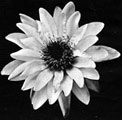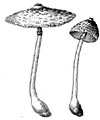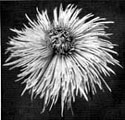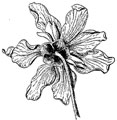Historical Essays on Garden and Forest
The Influence of Garden and Forest
on the Development of Horticulture
by Mac Griswold
Diverse Setting
|
Garden and Forest: A Journal of Horticulture, Landscape Art, and Forestry, the brainchild of the Arnold Arboretum's first director, Charles Sprague Sargent, was published during a period (1888-1897) when the science of everything that grows-wild or cultivated-was still (barely) considered a single discipline. It's as if today's readers of, say, Scientific American, Natural History, Martha Stewart Living, and The Nation could scan the weekly issue of a single sixteen-page magazine and find detailed articles of specific interest to them.
|
It can't go without comment, however, that Garden and Forest's readers were assumed to have general interests that far outran any narrow bounds of the subjects listed in its title. In 1889 Harper & Brothers, the New York publishing house, ran advertisements in the magazine for William Dean Howell's latest novel, April Hopes; for a Miss Juliet Corson's work on how to feed a family on $500 a year (subtitled A Daily Reference Book for Young and Inexperienced Housewives); and for a Civil War history written by an African-American who had served in the war, A History of the Negro Troops in the War of the Rebellion, 1861-1865, by G. W. Williams, LL.D.
Within this diverse setting Garden and Forest nonetheless published many editorials and articles that mark the beginnings of the specialized disciplines of horticulture, landscape architecture, botany, and forestry, with practitioners debating the directions their developing fields should follow. Horticulture, then as now, seems to have been the most vaguely delineated of the four, though as landscape architecture and forestry, previously considered to be aspects of horticulture, evolved into separate professions, the practice of horticulture became more circumscribed as well as more professional.
Horticulture
|
Before reading those debates therefore, it is wise to scan the pages of Garden and Forest for an idea of what was meant by "horticulture" in late nineteenth-century America. Today's general reader could assume that the term referred first and foremost to ornamental horticulture, as it does now. But in 1888 horticulture, which had piggybacked on agriculture since the days of colonial settlement, was still concerned with fruit and vegetable gardening to a very large extent. In 1988, the late Elisabeth Woodburn, an authority on horticultural literature, wrote an addendum to a new edition of U. P. Hedrick's A History of Horticulture in the United States to 1860 (originally published in 1950). Tallying books published on various "horticultural" topics between 1861 and 1920, she arrived at the following
|
ranking, from highest to lowest in number: fruits; vegetables; practical horticulture (propagation and cultivation); landscape and gardens (by which she meant design); and then flowers, flower gardening, and ornamental plants, which she ranked last.
Garden and Forest covered all these categories, offering descriptions of new species and of gardens and giving cultural direction and design advice. It also published articles specifically for greenhouse propagators and growers; articles for professional florists included a weekly flower-market bulletin. All this played a part in shaping the development of modern horticulture.
Most effective in promoting horticulture as a professional discipline separate from botany and landscape architecture, however, were some hard-hitting pieces that both criticized and set goals for horticultural training. For example, the publication in 1889 of an editorial on the negligible quality of American horticultural education in the same issue as a description of the French national school of horticulture clearly illustrated the two sides of the debate on professional training, the big question that eternally enlivens any discussion of horticulture being: How much is science and how much is practice?
Ideal Horticultural Training
|
Such American schools of horticulture as now exist, the 1889 editorial proposed, "provide an excellent course of botanical study and offer instruction in some branches of practical horticulture. It will not, however, be maintained by the best friends of these schools, that a well equipped gardener was ever graduated from any one of them."
The schools' problem arose from "the want of appreciation of the requirement of a sound horticultural education on the part of their founders, and in part from the prevailing tendency of the American people to be satisfied with a hasty and insufficient training for any vocation in life." Until there is a market for skilled men that will cause wages to rise, the piece curtly concludes, "our Schools of Horticulture can wisely give up trying to teach young men who do not want to be taught, and devote their energies to those wider fields of usefulness which, fortunately, are open to them, and by experiments, and in many other ways, at least help to create the demand for skilled gardeners which they were founded to supply."1
|
Garden and Forest's description of the three-year course at the National School of Horticulture at Versailles could be called its formula for an ideal horticultural education. This short piece is the work of Henry Sargent Codman, Charles Sprague Sargent's nephew and Frederick Law Olmsted's promising (and short-lived) young employee. At twenty-five he was studying in France with Edouard François André, the French landscape architect soon to be appointed head of the Versailles school. The essence of his piece is that of the editorial: American horticultural training needs more of the practical.2
An 1899 editorial argued strongly for a hefty dose of science even in the most practical applications of horticulture. It cited a pronouncement, both snobbish and categorical, by the then director of the Royal Botanical Gardens at Kew that "Horticulture is essentially an empirical art. Botanical science can afford little a priori information as to the cultural conditions which any plant will require or tolerate; these for the most part can only be found out by trial and experience."3 In other words, farmers and growers should not be taught science.
Physiological Botany
|
The editorial went on to offer a tentative but genuinely populist answer: "When it is stated that the gardener who has a genius for his work will 'naturally hit upon the right method' of cultivation, this means that the gardener has been doing just what the man of science would have done if he had been engaged in research in the same field. It seems to our people that a man who knows why he adopts a given method of cultivation is likely to be a more practical cultivator, less likely to fail in the essentials of the practice, than one who blindly follows the rule of thumb. Horticulture and agriculture, too, are no doubt largely empirical arts; but we sympathize in the belief that the addition of scientific knowledge will help to place them on a foundation more sure and productive than that of individual experience." In other words, farmers and growers should be actively involved in, and the beneficiaries of, scientific horticulture. Garden and Forest's balanced and democratic editorial stance may well be what, in the long run, did the most for the development of modern American horticulture.
|
The editors' stance was also well borne out in articles such as those by George Lincoln Goodale, the Fisher Professor of Natural History at Harvard. His long series on the principles of physiological botany helped to define the synergy between the scientist and the gardener as integral to modern horticulture, without any hierarchical distinction.4 His mild-mannered prose is as easily understood by a lay audience as by a professional one and his science would have been as useful to a greenhouse propagator as to an interested fellow professor. That is to say, his experiments were exactly those that would "help to create the demand for skilled gardeners" deemed so necessary in the 1899 editorial cited above.
Goodale's thirteenth piece, "Some of the Conditions Which Favor Rapid Growth-Certain Physical Phenomena of Growth," includes a vivid little section on the remarkable strength of cellular growth in plants. His final sentence on the prodigious and often hidden power of root growth could stand as a metaphor for the manner in which all the articles and much of the debate published in Garden and Forest helped lift modern horticulture to new heights by addressing a small, intelligent, interested, and yet demographically broad audience over a single decade. "The force exerted in all these instances," Goodale writes, "has been exercised solely by the innumerable delicate, thin-walled cells, which increase in number and in size in the orderly manner we have attempted to describe."5
AUTHOR: Mac Griswold's most recent book is Washington's Gardens at Mount Vernon: Landscape of the Inner Man (1999). She is also the author of "A History of Gardening in the United States," in The New Royal Horticultural Society Dictionary of Gardening (1992), edited by Sir Aldous Huxley, and co-author of The Golden Age of American Gardens (1991).
NOTES
2. H. S. Codman, "The National School of Horticulture at Versailles," Garden and Forest (hereafter, G&F) 2 (1889): 27.
3. "'A Gardeners' Problem,'" G&F 3 (1890): 149.
4. "Principles of Physiological Botany as Applied to Horticulture and Forestry," G&F 2 (1898): 8-9, 20-21, 32-33, 44-45, 56, 68-69, 80-81, 92, 104-105, 116-117,128-129, 140-141, 153, 164-165, 177-178, 188, 201-202, 213-214, 225, 249-250.
5. Ibid., 153.









